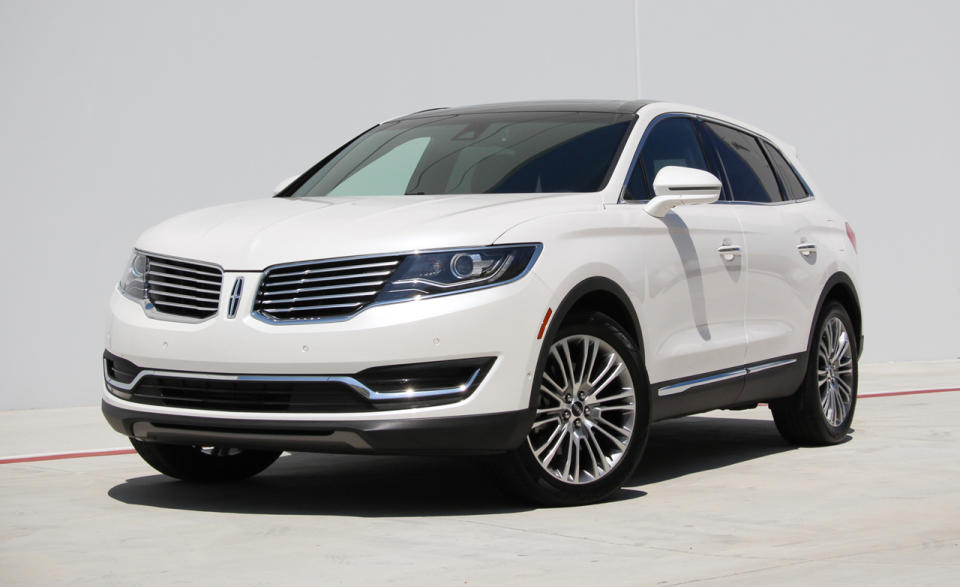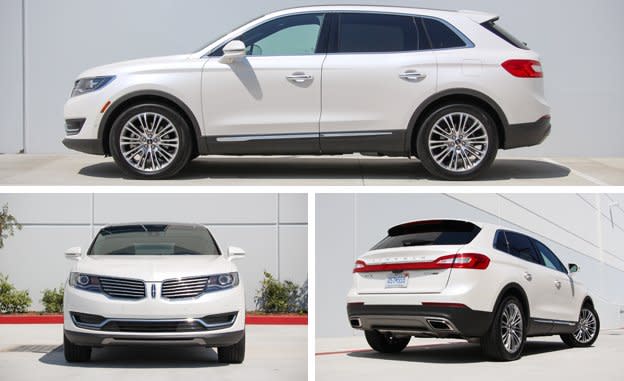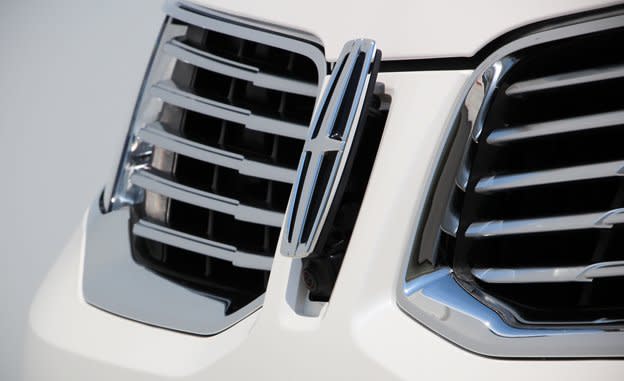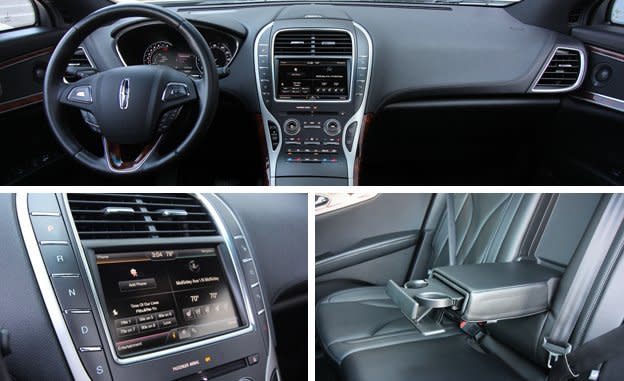2016 Lincoln MKX 2.7T FWD

We’ve been warned about expectations. “No expectations, no disappointments,” read one familiar saying we saw on a wall plaque somewhere. Another one read, “Expectations are merely resentments under construction.” But when it comes to luxury vehicles such as the Lincoln MKX, the prices charged by their makers inevitably raise certain expectations.
As the ostensibly cushier expression of FoMoCo’s two-row, mid-size SUV architecture that also underpins the square-jawed and generally appealing Ford Edge, the elegantly styled Lincoln MKX makes certain promises. We found many of those were fulfilled and even surpassed when we tested a swift, slick, if rather pricey ($63,275 as tested) MKX 2.7 turbo with all-wheel drive. We praised its precise handling, strong acceleration, and comfortable cabin. So how much different might the front-wheel-drive model be with that same great engine? And what if it were priced closer to what people might expect to pay for a Lincoln rather than a BMW X5 or a Porsche Cayenne?

As it turns out, when it comes to the most powerful MKX, all-wheel drive and heaps of options make the difference between exceeding expectations and failing to meet them.
Power without Grace
On paper, the $2000 charge to swap out the MKX’s base engine—a 3.7-liter naturally aspirated V-6 making 303 horsepower—for the optional 335-hp 2.7-liter turbocharged V-6 seems a no-brainer, if only for the attendant boost in peak torque, from 278 lb-ft at 4000 rpm to 380 lb-ft at 3000 rpm. One might also expect that, by carrying nearly 300 pounds less than the all-wheel-drive model, the front-drive 2.7 turbo model might serve up quicker zero-to-60-mph acceleration times. (Or at least matching ones.) Nope. The best we could muster with the front-driver was a lackluster 6.9 seconds, 0.9 second behind the all-wheel-drive MKX and 1.3 seconds behind the Ford Edge Sport, which is powered by a detuned version of the same engine with 315 horsepower and 350 lb-ft of torque.
What gives? Low-speed traction. At anything beyond half throttle, the MKX just can’t get a grip. The comfort-oriented suspension allows serious rear-axle squat under acceleration, pitching the nose up and unloading the front wheels, resulting in fruitless wheelspin. If there are pavement irregularities or a whiff of steering input when the power comes in, the driver needs both hands on the wheel to keep pointed straight. Stability control actually seems to worsen this effect, applying the brake to one front wheel, then the other, generating a seesaw response. We’re talking about steering-wheel-yanking torque steer like you haven’t seen since a 1980s Saab Turbo. Much of the 2.7T’s extra power goes to waste when it can’t route excess torque to the rear wheels. We tested during dry conditions in California and can’t imagine how rambunctious it might be in the wet or in snow.
Aside from that, the smooth turbo six is a good companion. It barely whispers at speed, and combined with a dearth of wind and road noise (thank you, noise-cancellation technology), the MKX registers just 64 decibels at a 70-mph cruise, five decibels quieter than the Edge Sport, matching such paragons of serenity as the Lexus LS. Expectations met.
Smooth Operator, Until You Stop
Also meeting expectations of the Lincoln brand is a deliciously silken ride, thanks to adaptive dampers that absorb bumps like Bounty sucks up spilled Kool-Aid. When we reviewed the all-wheel-drive model, we noted that drivers need to dig deep into the Sync infotainment system’s menus to change the chassis tuning among Comfort, Normal, and Sport settings. The front-drive edition avoids that annoyance with a system that isn’t adjustable at all; instead, the single-tune setup’s responses are dictated directly by how you drive. Feed in the steering gently, and the vehicle stays rather flat as side loads build; turn quickly, and the MKX heaves over like a container ship in the North Sea. A major dead spot in the steering at center prevented this model from feeling terribly precise, no matter how heavy the steering got at high speeds.

Our test example’s vague brake pedal also made even the most concerted attempt at smooth stopping an exercise in futility. Initial pedal application produced little response. Then, at some point midway through the pedal travel (a point that was still unpredictable even after two weeks spent with the vehicle), a sudden onslaught of stopping power would hurl forward anything not glued to the seats—heads, arms, cargo, dogs, hot cappuccino—in unseemly fashion. The MKX gives the impression of enormous stopping power, but our 70-to-zero-mph braking test actually produced a lackluster 186-foot stopping distance, 15 feet longer than the AWD model and 10 longer than the Ford Edge Sport AWD. Anything beyond 180 feet is too long for this class, where leading luxury-brand competitors can stop from 70 mph in 160 to 170 feet.
Much of what we disliked about this MKX’s dynamic behavior was absent in the all-wheel-drive model. The tidier handling and better directional control of the AWD version can be attributed not just to the added rear-wheel traction but also to the driver-selectable dampers, which, left in Sport mode, kept body motions in check. Our advice: Spend the extra $2495 for the all-wheel-drive edition, or save $2000 by sticking with the base 3.7-liter engine. Going with all-wheel drive erases 2 mpg from the EPA rating on the highway (24 versus 26 mpg), while the 17-mpg city figure doesn’t change. In reality, we recorded 20 mpg in the AWD model but only 17 mpg in this front-driver—the reverse of expectations.
Vinyl, Vinyl Everywhere
Like the other MKX we tested, this one arrived in Reserve trim—the penultimate version, just below the Black Label model (more on that later)—and its relatively attractive as-tested price of $54,365 included the $1650 Driver Assistance package (lane-keeping assist, interior mirror with camera, automated emergency braking, and adaptive cruise control), the $1720 Technology package (active park assist, front parking sensors, and a 360-degree camera), the $1155 Revel audio system, $250 inflatable rear seatbelts, a $595 Climate package (heated rear seats, heated steering wheel, and rain-sensing wipers), a $695 White Platinum paint job, and a $60 Enhanced Security tag. It lacked the 22-way front seats ($1500) that were in our all-wheel-drive test car. We missed them, finding ourselves sitting on wide, lounge-like chairs that allowed too much body movement during turns. Our test car also had dreary all-black upholstery, with vast expanses of shiny vinyl on the dash and upper door panels that were made only slightly classier with stitching. The luxury vibe is further compromised by hard plastic in the lower door panels and the center console, with still more plastics doing their best impressions of wood, aluminum, and graphite surfaces.

On the plus side, Lincoln had the good sense to reinstate conventional buttons and knobs for the MKX’s stereo and climate controls rather than continue with the sliders and capacitive touch controls of the previous MKX. We also appreciate the open lower deck of the center console. And the rear seat is absolutely massive.
Much of the MKX’s interior cheapness is alleviated when you choose the Black Label trim, which coddles passengers with Venetian leather, genuine wood, and real metal, coordinated among one of four different design themes: Modern Heritage, Thoroughbred, Indulgence, or The Muse. Black Label models also bring a different ownership experience, says Lincoln, complete with a concierge, free car washing, a yearly detail, and remote pickup and delivery services. But that comes at a steep price. A Black Label model with the 2.7-liter EcoBoost mill and a similar level of equipment as the Reserve version we tested costs nearly $61,000—even more if you opt for the 22-way seats or all-wheel drive. At that price, Lincoln finds itself in a space where expectations are higher still.
While Lincoln has opened up more space than ever between its MKX and the more plebeian Ford Edge, having even one model in the range exhibiting drivability issues as extreme as the torque-steer problem this car had—disregarding the low-grade plastics and vinyl inside—makes it harder to consider Lincoln a worthy competitor to Mercedes-Benz and Audi. If Lincoln wants to meet the rightful expectations of luxury shoppers, all of its models, not just one combination or two, need to drive well and look good. While a dressier interior in lower trim levels would go a long way, another step in the right direction would be to make all-wheel drive standard with the turbo engine.
Specifications >
VEHICLE TYPE: front-engine, front-wheel drive, 5-passenger, 4-door hatchback
PRICE AS TESTED: $54,365 (base price: $46,240)
ENGINE TYPE: twin-turbocharged and intercooled V-6, iron block and aluminum heads, direct fuel injection
Displacement: 164 cu in, 2694 cc
Power: 335 hp @ 5500 rpm
Torque: 380 lb-ft @ 3000 rpm
TRANSMISSION: 6-speed automatic with manual shifting mode
DIMENSIONS:
Wheelbase: 112.2 in
Length: 190.0 in
Width: 76.1 in Height: 66.2 in
Passenger volume: 107 cu ft
Cargo volume: 37 cu ft
Curb weight: 4382 lb
C/D TEST RESULTS:
Zero to 60 mph: 6.9 sec
Zero to 100 mph: 18.7 sec
Zero to 120 mph: 31.5 sec
Rolling start, 5–60 mph: 7.0 sec
Top gear, 30–50 mph: 3.2 sec
Top gear, 50–70 mph: 4.4 sec
Standing ¼-mile: 15.4 sec @ 94 mph
Top speed (governor limited): 133 mph
Braking, 70–0 mph: 186 ft
FUEL ECONOMY:
EPA city/highway driving: 17/26 mpg
C/D observed: 17 mpg

 Yahoo Autos
Yahoo Autos 